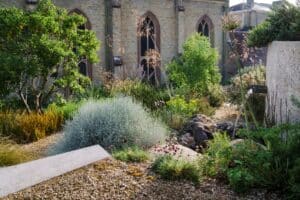Isle of Wight Garden
completed: 2019
client: private
photography: Rachel Warne
The site, with a north facing 1:3 slope, was a place for goats not people. Inaccessible and unusable the house sat at one end of the plot with a steep, isolated grass bank at the other. An empty island amongst the neighbouring buildings, this lawned desert lacked interest and biodiversity and was completely exposed to the weather, to neighbours and to passersby. The adjacent grade II listed church loomed over the garden and was such a powerful presence that it completely dominated the place.
I wanted to make a garden with atmosphere and character that embraces you when you leave and welcomes you when you return home. Winding paths now lead down and across the slopes to a new entrance in the bottom corner. Curved retaining walls like scattered petals create level seating areas, shelter and shade and provide a backdrop to the new architectural planting and opportunities for lighting. Steps were kept to a minimum by working with the slope and coupled with curving paths encourage movement and exploration.
A series of water chutes and rocky pools flow down the slope and bring the garden to life.
New planting created clear vistas to the sea while partially obscuring neighbouring buildings, including the church by balancing its vast bulk with the canopies of new trees. We blurred the boundaries to unite the house and garden with the wider setting and knitted it into its site. The mass of planting introduced a heart to the garden, an intimacy and a level of privacy.
The Mediterranean planting relies heavily on structure, texture and evergreens to ensure the garden remained beautiful even in the depths of winter. Bulbs, perennials and grasses bring colour throughout the year and there is something to catch the eye at every turn.
I used Portuguese limestone was used with hand fettled step edges to bring a crisp contemporary quality with a hand worked element. The same material was used for stone seats and more rustic steps.
Glacial boulders were brought in for the water features and to retain some of the stepper planting beds without the need for walls.
Concrete retaining walls were poured in layers to give the appearance of rammed earth and several different mixes of aggregates were used to give contrasting colours.
